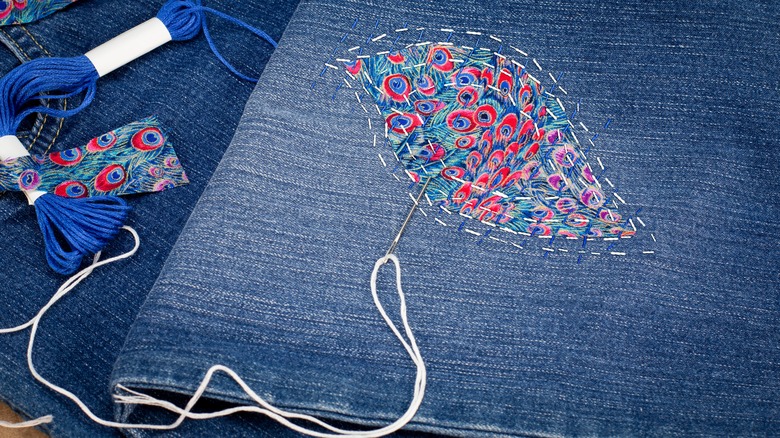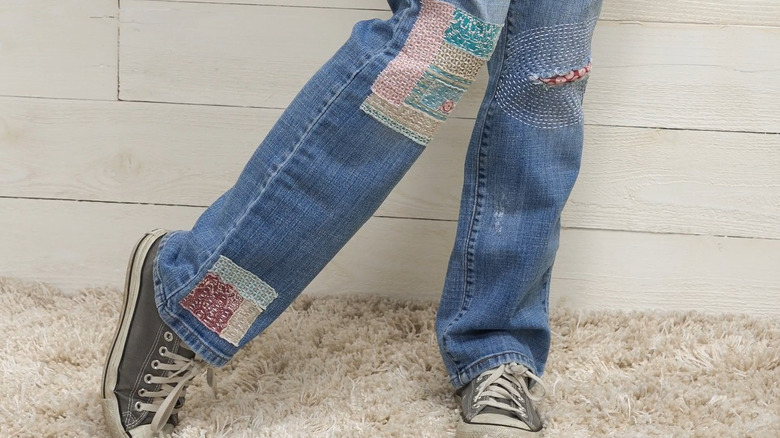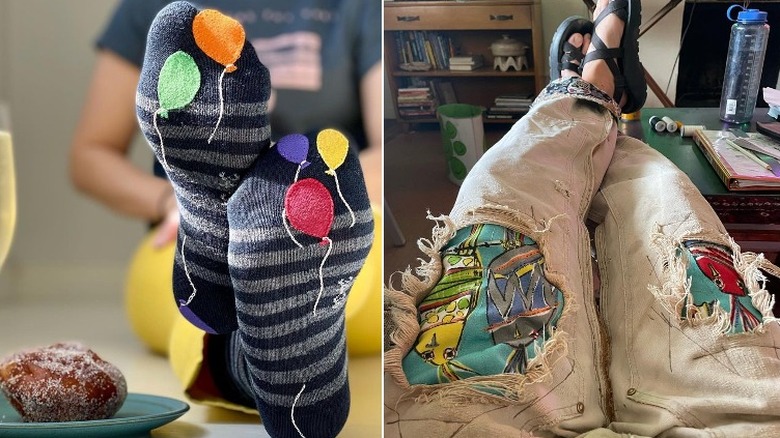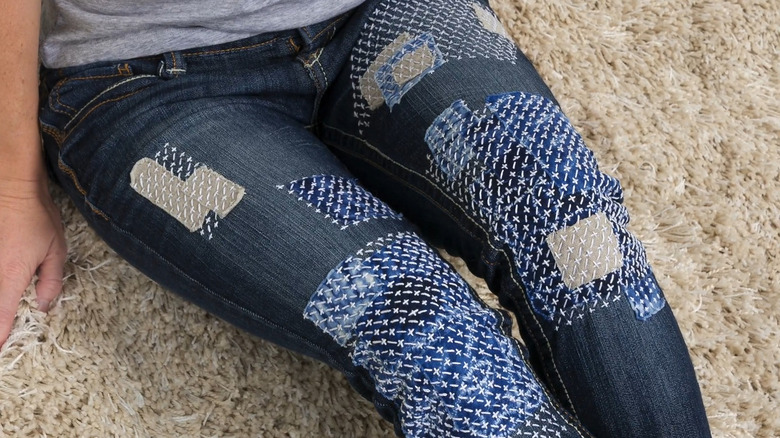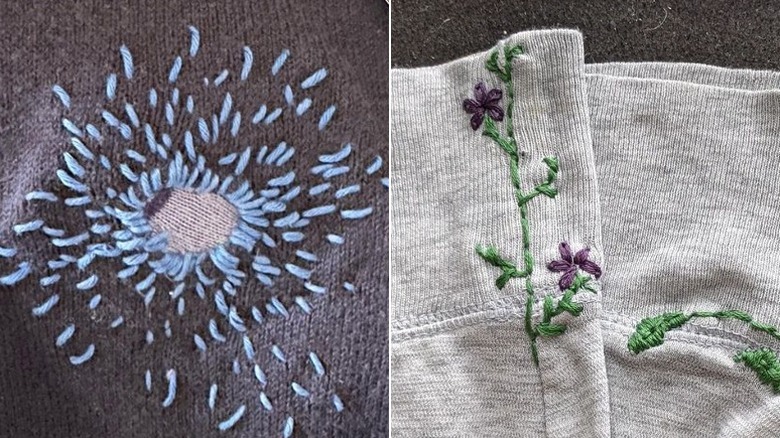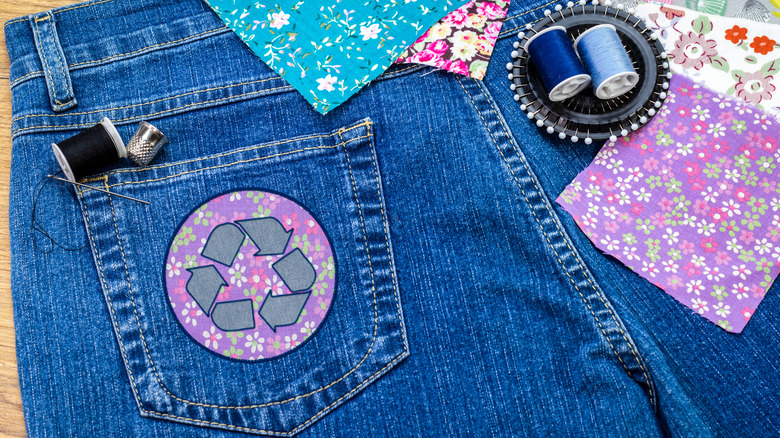Visible Mending Brings Cool Updates To Your Old Clothes (It's Sustainable, Too)
Fashionistas love to have lots of clothing options — even if they can't always wear them — and the rise of Fast Fashion since the 1990s has made that easier. Brands like H&M and Zara offered cheaply-made, inexpensive clothing to match quickly changing trends, encouraging people to buy more and toss them even quicker, treating clothing as disposable items. Online stores like Amazon have deeply worsened the trend.
Despite its convenience, Fast Fashion has become devastating for the environment. A reliance on cheap, synthetic materials like polyester and nylon, which are unsustainable and not biodegradable, has increased fossil fuel use and CO2 emissions. Fast fashion demands the constant expenditure of resources, fiber waste, water, and air pollution, cheap labor, and poor working conditions. This leads to consumers buying more, wearing less, and throwing garments away sooner. All this to say, the fashion industry has been a detriment to planet Earth. 80% of old clothes end up in landfills or incinerated. Yet 95% of those textiles could be recycled and aren't.
While clothing manufacturers should take more responsibility for their carbon footprint, consumers can also do their part to reduce the amount of clothing that gets thrown away. According to Greenpeace, "The simplest step we can take is to wear our clothes for longer," which decreases their environmental impact. Plus, who wouldn't love to get more use of our cherished sweater or pair of jeans? You can even express your creativity and personality through your old clothes. One way to achieve all this is with visible mending.
What is visible mending?
Visible mending is pretty much what it sounds like: a means of fixing clothes in a decorative, transformative way, turning your old garment into something new and fashion-forward. It flies in the face of fashion in many ways, requiring an open mind and bold thinking for what your old garment can become, while letting go of what it once was. "There is a form of acceptance that happens when it comes to doing visible mending," seamstress Drea Johnson told The Zoe Report. "You're accepting that there's a part that's not working, but it doesn't mean that the whole thing isn't working."
Before Fast Fashion, when clothes were more expensive and harder to get, it was imperative to mend clothing to make them last as long as possible. It was also the fashion to mend imperceptibly, invisibly, as holes or stains were signs of poverty. But in the 1970s, when distressed clothing came into fashion, people intentionally bought ripped jeans and patched sweaters made by manufacturers. Today, visible mending allows fashionistas to not only adopt this trend, but make it uniquely their own.
While invisible mending requires expertise to hide the flaw completely, visible mending isn't concerned with hiding the flaw, but transforming it into a new beauty. Not only will mending items yourself make them one of a kind, but you implement your own personality and creativity. It's fun, inexpensive, and easy to get started, with lots of techniques to try.
Patches and appliques are one of the simplest forms of visible mending
Whether covering a hole with a patch, using contrasting colors to darn, or adding fancy stitches to turn a flaw into something beautiful, there are many techniques including embroidery, knitting, crocheting, and dressmaking, to easily and artfully mending your garments. Turn your worn-out skirt into a good-as-new fashionable item.
One of the simplest ways to mend holes in clothing is with patches or appliques. Iron-on or sew-on patches are available everywhere, from Target and Hot Topic to Amazon and Etsy. You can even make your own appliques using fabric and interfacing, and use patches and fabric scraps can either match or contrast what you're mending. You can place the patch on top of the hole, either using a raw edge stitch (meaning the stitching will show) or using a needle turn applique, (which hides the stitching under the turned edge of the patch). You could also use reverse applique by putting the piece of fabric under the hole so that it shows through.
Then, make your patch even more fashionable by using different stitches to secure it. A simple running stitch will do, or you can use something more decorative, like zigzag, feather, cross stitch, or blanket stitch, to really turn your patch into something special. Any stitch can be decorative as well as functional, whether you use a matching thread color or a contrasting one, and there are so many stitch types to choose from, so get creative! One popular technique of stitching used in visible mending is Sashiko stitching.
Sashiko stitching is a popular visible mending technique
Another trendy technique for visible mending which can be used over appliques and patches or on its own, is called Boro or Sashiko stitching. "It can be traced back to early Japan, like the Edo period," says textile artist Katie Berman, "and was a way for the working-class people to essentially elongate the life of their clothing." Sounds perfect! If you use a patch, Berman recommends matching the fabric weight of the patch with the fabric you're mending.
Often translated as "little stabs," Sashiko stitching is a type of embroidery that uses variations of the running stitch to create intricate repeating patterns. Useful for filling large sections of fabric, the stitching not only looks beautiful and elaborate, but it makes the fabric stronger. It's inexpensive, requiring only Sashiko needles and thread. It's also easy to begin, and you can learn more complex patterns as you go.
Using a Sashiko needle, which is slightly longer and stronger than embroidery needles, you can start with simple lines of running stitches. One of the most difficult parts of Sashiko stitching is keeping your stitches straight, and there are techniques that will help with that. As you get comfortable, you can create more complex patterns, like plus signs, zigzags, crosses, butterflies, or other designs. In fact, some patterns have different meanings or connotations, such as wishing prosperity or healthy growth, or warding off evil. There are also guides and tracings you can purchase to follow and create more exciting designs.
There are even more visible mending techniques
As if patches, appliques, and Sashiko stitching weren't enough to play with, here are more visible mending techniques to turn that old garment into something new.
Turn small moth holes into a feature, rather than covering them up, by converting them into portholes. Use a colorful thread to outline the hole with an eyelet stitch, which enforces and restricts the hole while you make it pretty. If you want the hole a little bigger, more of a feature, you can pull the thread tighter. Or if you'd rather cover the hole in a decorative way, try needle weaving. This technique covers the hole with thread in a tightly woven hash pattern that binds its edges from getting larger. Traditionally meant for fixing knitted garments, it's also good for other fabrics like denim and flannel. You can use a single-color thread or combine multiple colors for a more dynamic pattern.
If you'd like to try more complicated techniques, you can branch out into embroidery, crocheting, and Swiss darning. Don't let these scare you. Embroidery, for one, is not as complex as it seems. It requires precision, but the stitches don't have to be complicated, and YouTube tutorials are your friend (as they are for any of these techniques). Using basic stitches like satin, stem, or chain stitches, you can embroider cute little designs like leaves, bumble bees, cherries, or small animals to strategically cover your holes. Be brave! Since you're already fixing "broken" items, it doesn't matter if you make mistakes.
Not convinced? Here are more reasons to try visible mending
Hopefully we've shown you that visible mending is a fun, easy way to extend the life of your garments. But if you still need convincing, here are a few more reasons to try it.
Visible mending is done by hand, so many find a meditative aspect to it. It's easy and inexpensive to start, especially if you already have sewing supplies in your home. Yes, it's experimental and improvisational, which can be daunting, but don't be afraid. Since it's personal, there's no such thing as mistakes. The best part is, if you don't like something, you can undo it. Even if you don't consider yourself creative, follow the Instagram hashtags #visiblemending or #sashiko for inspiration.
There is a sense of comfort and security in fixing your own clothing. It also shows respect for the item, its history, and clothing makers by delving into how the garment was made as you try to maintain its longevity. You can also draw comfort from knowing you're helping the planet by mending and upcycling; Rather than line the pockets of potentially pollutive or exploitative clothing manufacturers, you're creating new articles of clothing from old ones. You'll keep garments in your closet, rather than a dumpster, with a new personality and uniqueness that's all your own. Or if you prefer to outsource your visible mending to a shop or artisan, you can practice inclusivity and diversity by supporting small, queer and/or BIPOC-owned businesses. You'll feel better about your clothes and your environmental footprint.
